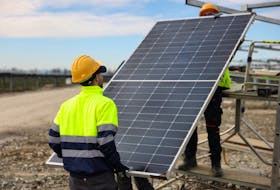Company president and CEO Kirby Mercer announced Friday the goal is to establish a manufacturing site on the water, bringing jobs and economic spinoff to western Newfoundland.
The only questions left are how that will be done and when.
The company has been in discussions with the Corner Brook Port Corp. for two years now, but there has been no site selection yet, or any formal agreement signed, despite the port’s publicly stated interest in new users.
“We’ve agreed to work with them, to help them identify a site and to move the project forward,” said Jackie Chow, CEO with the Corner Brook Port Corp.
“There’s a fair bit of environmental and assessment work that will have to be done in order to firm up a site,” she said.
Environmental assessment is required to establish a manufacturing facility in the community. According to the provincial Department of Environment and Conservation, there has been no proposal submitted to government requesting approval for any such facility.
Similarly, the Department of Environment has yet to receive a proposal for an offshore “demonstration” wind farm — something Mercer also announced as part of his company’s plans.
Mercer said Beothuk Energy plans to erect 30 six-megawatt turbines in the Gulf of St. Lawrence, capable of producing 180 megawatts of electricity. The installation would cover about 40 square kilometres.
Nalcor Energy, and specifically Newfoundland and Labrador Hydro, have to approve any feed of power into the grid in this province, as per provincial legislation. The Crown corporation confirmed it has not been approached by anyone from Beothuk Energy about an offshore wind farm.
“Our market is the Northeastern United States and the eastern part of Canada. It’s nothing to do with Newfoundland or Nalcor,” Mercer said Monday.
“We’re going to be closer to the mainland than we are to Newfoundland.”
He would not say where his company’s demonstration wind farm would actually be built, other than to say it will be in the Gulf of St. Lawrence and the technology available to the company will allow economic construction 50 miles offshore.
When asked who might help to cover the estimated $400-million capital cost, he said the financing remains private and there has been no government funding to date, other than input from the Atlantic Canada Opportunities Agency (ACOA) for an economic study.
According to online records, ACOA has provided a single, non-repayable contribution to Beothuk Energy of $50,000, towards a $67,000 “economic analysis report.”
Details are scanty
“The reason why everything’s not totally finalized (for the manufacturing site) is a lot of things are going to be based on design and the final design of even the gravity base structure and the final requirements that we need. And until that’s totally done, the final requirements are not in place,” he said.
Asked about employee numbers and partner companies — including the engineers Beothuk Energy has working on the details of its gravity base structures — he said more information would be provided in announcements “coming shortly.”
Mercer is promoting the “green energy” of offshore wind, having previously been involved in oil and gas exploration in western Newfoundland, through Canadian Imperial Venture Corp.
“It’s an energy business,” he said, when asked about the transition, adding he sees the potential in the untapped resource of offshore wind, just as teams of companies in Europe have recognized.
Traditionally tough sell
In North America, there has been slower uptake on offshore wind as an energy source. Projects that have progressed to date have done so slowly — with survivors close to development now having at least a decade of consultation and regulatory review behind them.
In the United States, seven offshore wind demonstration projects received support from the U.S. Department of Energy in 2012, totaling $168 million over six years. The projects include the Lake Erie Energy Development Corp. (LEEDCo) plans to build five to nine wind turbines about 11 kilometres offshore off the coast of Cleveland, Ohio, and the Cape Wind project off Massachusetts, promising to be the first offshore wind farm in the U.S.
In Canada, a moratorium on offshore wind was installed in Ontario in 2011, remaining in place and stalling projects of several companies active in the Great Lakes. The moratorium has prompted lawsuits against the government, valued in the billions of dollars.
In British Columbia, Vancouver-based NaiKun Wind Energy has continued to progress its plans for an offshore wind farm in the Hecate Strait, with almost 400 megawatts of capacity from 110 turbines between the mainland, at Prince Rupert, and the archipelago of Haida Gwaii.
Official consultations for that project date back to 2003, though president Michael O’Connor said he expects to reach development in the next two years.
Newfoundland and Labrador’s Natural Resources Minister Tom Marshall said Beothuk Energy briefed staff in his department prior to the company’s public announcement.
“We’ll see what happens,” he said, adding he was excited by the prospect of the new energy enterprise.
Beothuk Energy has a Twitter account (@BeothukEnergy). Its website is still under construction.

![['Kirby Mercer.']](https://saltwire.imgix.net/kirby-mercer-2438023.jpg?cs=srgb&fit=crop&h=568&w=847&dpr=1&auto=compress%2Cformat%2Cenhance)







